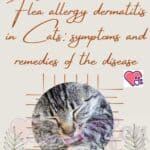
Cat fur allergy is the most common allergy among us humans, but we actually see the true cause, symptoms and treatment.
The love for the cat can reach unexpected levels and the furry friend can be part of the family, as a member. In addition, cats improve and strengthen the immune systems of the children they live with. But what to do if you have a cat allergy? About 10% of human respiratory allergies are triggered by cat fur. So if you think you have this type of allergy, before making the final decision not to share the house with your furry friend again, read the advice contained in this article.
Cause and contagion of cat allergy
The term “cat hair” allergy is not really appropriate: it is actually an allergy to a particular protein called Fel d1 contained mainly in the saliva and sebum (secretions from the sebaceous glands) of the cat .
This tiny molecule, however, can be a great threat, despite its size. The protein itself is harmful and becomes even more dangerous when it is released together with the cat’s fur, that is, when it is deposited throughout the house together with dandruff, that is, dead skin visible in the fur of cats: they are tiny white dots, five times smaller than dust.
Due to their very small size, these points remain suspended in the environment for a long time, and as in people, they are dispersed throughout the environment. And just when the cat licks its fur during grooming, it spreads these dry skin cells all over the body, and once the feline hair comes off, these allergenic proteins spread too.
This malignant protein, present in cat fur, triggers the allergic reaction when it enters the body of vulnerable people, that is, with an immune system that is more sensitive than normal to these substances. However, there are some breeds that secrete less Fel d1 proteins and shed little hair: they are Cornish rex, Devon rex, Balinese and Korat.
Without forgetting the naked cat. If the allergenic potential of these cats is low, however, it is not zero; the risk of having an allergy develop or persist cannot be excluded.
Symptoms of cat allergy
The symptoms that people with cat fur allergy can exhibit are very different and can appear after a few minutes / hours in the presence of a cat. They get worse if the allergic person touches, strokes or approaches the animal. Symptoms can also appear in a room where a cat used to be, or even in the presence of someone who has a cat. Among the most common symptoms are the following:
- itching in the body;
- sore throat;
- redness;
- swelling;
- nasal congestion;
- urticaria;
- sneezing;
- cough;
- lacrimation;
- mucus;
- eye irritation
- skin rashes;
- worsening of asthma – in those suffering from this disorder.
The appearance of any of these symptoms is reason enough to contact the allergist , who, through appropriate tests, will confirm or rule out the suspicion of cat allergy and, in the first case, will recommend the appropriate treatment.
Diagnosis and treatment of cat allergy

The suspicion of cat allergy arises with the presence of symptoms concomitant with the presence of a feline. The precise diagnosis is made by the allergist through skin tests. This examination, or prick-test, consists in placing a drop of an extract containing the Fel d1 allergen, generally on the skin of the arm.
The doctor then performs a small, painless injection to penetrate the product into the epidermis. After 15-20 minutes, if redness appears on the skin, the test is positive. The greater the erythema, the stronger the allergy. A blood test is also performed for anti- Fel d1 antibodies.
Symptom treatment is based on local (nasal spray, eye drops, etc.) or general (tablets) antihistamines or corticoids (strong anti-inflammatories ). An asthma attack requires specific treatment, usually based on inhaled salbutamol.
Desensitization, on the other hand, allows the body to become tolerant of feline allergens again. It is based on injections or administration of drops sublingually for several years. Its effectiveness is questionable when it comes to cat hair allergy.
Prevention
The absolute prevention would be to avoid the cat, but as we have already said it is often part of the family and the benefits it brings are greater than the negative factors such as an allergy can be. The final eviction of the cat is a means of prevention that must always be discussed because its psychological impact can be significant, especially if the children live indoors.
So once you have consulted your doctor or rather an allergist. Diagnosis is confirmed with a simple blood test or skin allergy test and symptom severity assessed. Your doctor may also advise you to live without a cat for a few months to see if the allergy symptoms improve. Here are some tips from the experts:
- Ventilate the house or apartment every day, even in winter.
- Brush your cat regularly, outdoors if possible. Collect as many hairs as possible and lock them in an airtight plastic bag.
- Put a wet glove on the cat’s coat every day or every other day. This will prevent it from spreading hair and dander around the house.
- Clean the litter box as often as necessary.
- Use a vacuum cleaner with a HEPA filter: these are highly efficient sieves capable of trapping the smallest air particles.
- Use fewer carpets and smoother, more washable surfaces.
- Use a protective mask: if you are allergic and have no choice but to remove the dust, remember to do it with a suitable mask, which prevents the passage of allergens in the respiratory tract; however, avoid this task as much as possible.
- Do not let the cat sleep in the allergic person’s bed.
- Store all clothing in closed closets.
Of course, if you are allergic, you could delegate all cat care to a non-sensitive person.






